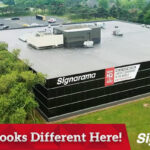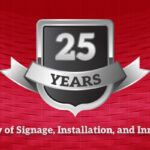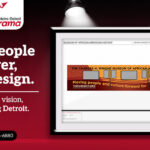Building signs are a great way to get your message to people before they even walk in the door. Whether it’s 3D letters, an illuminated sign box, or custom metal signs, building signs are an important way for your business to reach customers. Still, not all building signs are created equal. So we thought we’d bring you some exterior building signage examples—highlighting both the good and the bad.
Not all exterior building signage examples are repeat-worthy
Yes, you heard that right—the bad signs. We’re not going to take a pie-in-the-sky approach that makes it look like all companies nail their signs every time. In fact, there is such a thing as a sign fail. And when it comes to sign fails, here’s all we know—you don’t want it to be your company.
What not to do
That’s why you can afford to take a moment to learn what others have done wrong. Once you know what they’ve done that hasn’t worked out so well, you can avoid doing it yourself. So let’s start with a few building sign “don’ts.”
Don’t misspell critical words (or any words at all)
Not only should you be shooting for sign copy that’s going to be effective, but you should also be looking for quality. And that means you need to proofread. After all, you want your potential customers and clients to take you seriously. So you need to present your company as a place where people know what they’re doing.

Naturally, this includes spelling. A misspelled word is a painful thing to behold. You may think twice about sending your child to an education center that can’t spell correctly!
Or take your cue from the window signs at the car dealership in this photo from the Press-Enterprise. It looks like lending fraud isn’t the only problem this story highlights. Whether intentionally or not, we’re getting a front row seat to a very visible spelling error.
What the dealership wants to say is, “Bad Credit? You’re Approved!” What they actually say leaves a lot to be desired. Where is an apostrophe when you need one?
Don’t leave characters crooked
Whether it’s channel letters, dimensional letters, or address numbers, don’t affix them to your building in a topsy turvy way. Instead, ensure that they’re placed so they line up neatly—both with the building itself and with the other letters in the group.
Don’t fail to replace broken lighting
Many of us have seen this one before—a lineup of front-lit channel letters with one or more of them conspicuously not illuminated. Don’t let it happen to you. For one thing, it will look just plain broken (and who wants their business to project an image of brokenness?).
Second, it could turn your company into a completely different business. Like the Burlington Coat Factory that lost illumination for the o in Coat and became the “Burlington Cat Factory.” That one probably takes the cake for the fastest way for a business to change industries—from a clothing store to a pet store.
What to do
Now that we have the not-so-good exterior building signage examples out of the way, let’s take a look at the positive side. Time for a healthy dose of success and positivity. Here are some signs from which we can learn a few things worth imitating.
Do go big if you need to be seen
Teeny tiny letters are not going to help clients take an unplanned turn off a highway exit to visit your restaurant or grocery store. Obviously, visibility is important. Unless, of course, you’re actually trying to hide your business’ location so nobody can find you. Which you might do if you’re the Secret Service operating out of an unmarked building in Washington D.C. However, most likely you’re not the Secret Service, so we’ll assume you want your customers, clients, and community members to see you.
Depending on your situation, getting seen could call for going big—big letters, big logo, etc. However, don’t confuse big with wordy. Big signs could actually have very few words. For example, check out the sign Turner Sign Systems made for Uncle Julio’s. It’s succinct, very visible, and—may we say—big.
Do match your sign to the feeling you’re trying to create

Let’s have a thought experiment…Imagine for a moment that two groups with well-recognized logos are going to swap logos for the duration of their existence. Hmm, you think, that’s not a terrible idea. It could work.
Yes, it could work—until you learn which two entities and what two logos. So, here goes. Let’s say that the United States Marine Corps is going to switch logos with Walt Disney Pictures. Right—now it’s getting concerning. What’s wrong with that picture?
Well, the symbols that represent those two groups carry a lot of meaning. And if you tried to switch the two, you’d have what we could call a sign mismatch. (Not to mention a lot of armed and angry Marines and not few upset Disney fans).
Really, this is a great way to visualize the idea that you need a sign that “matches” your company. For instance, with a name like Smiling Moose Deli (see photo 1)—you need an imaginative, even whimsical sign. In the same way, when your building aesthetic says ‘classic’ or ‘old fashioned’ and you embrace timeless professionalism, then it’s time for a sign that evokes a classic feel.
Look, listen, & learn
As you select your own building signs, do your best to learn from these exterior building signage examples. Model your sign after those who have done well, and avoid the pitfalls of those whose signs didn’t quite cut it. But don’t stop there—keep learning about what you should do to craft great signage for your company. Take a look at The Importance Of Good Signage & The Psychology Behind How It Works. Then, try 6 Elements You Must Include On Your Sign | Tips On Layout & Design.




